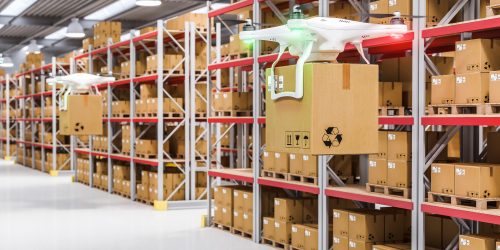Focus on the green supply chain
The effects that the Covid-19 crisis has had on the supply chain are numerous and often very positive. As well as illustrating its strategic, even vital importance for many companies, the quest for supply chain resilience is based more than ever on a CSR approach, mindful of the need to protect the environment and contribute to the sustainable growth of companies and our societies. As its name suggests, the main objective of the green supply chain is to reduce the environmental impact of logistics and transport.
What is the green supply chain?
For several decades now, environmental problems have been rapidly multiplying and spreading across countries and regions around the world, constituting a serious contributing factor to climate change and global warming.
The concept of the green supply chain aims to mitigate environmental degradation and to control air and water pollution and waste generation through the adoption of environmentally friendly practices in various business operations. The end goal is to improve environmental sustainability.
Indeed, the green supply chain not only reduces environmental pollution and production costs, but also stimulates economic growth, creates a competitive advantage in terms of customer satisfaction, positive image, and reputation. The concept of the green supply chain is gaining momentum with innovations and new techniques aimed at protecting the planet.
The term “green supply chain” refers, by definition, to the idea of integrating sustainable environmental processes into the traditional supply chain. This may include processes such as the selection of suppliers and procurement of materials, product design, manufacturing and assembly, distribution, and end-of-life management.
Instead of mitigating the negative impact of business operations and the supply chain, the green supply chain involves adding and/or creating value through the operations of the entire chain. Undoubtedly, the reduction of air and water pollution and waste production in the industry is the main objective of the green supply chain. Green operations, meanwhile, improve companies’ performance in terms of:
- Waste reduction;
- Products reuse and recycling;
- Lower manufacturing costs;
- Increased efficiency of assets;
- Building a positive image;
- Customer satisfaction.
A favourable context for the green supply chain
As the IPCC (Intergovernmental Panel on Climate Change), reports are mounting up and global warming is becoming a reality for us all, the green supply chain is also becoming a valuable governance tool for organisations. In Europe, public authorities are encouraging the ecological transition as well.
The Green Deal for Europe, set out in December 2019, aims to make the European continent a leader in carbon neutrality by 2050. The Green Deal is financed to the tune of €1,000 billion over 10 years by all EU countries.
The green supply chain, a holistic approach for sustainable results
To make the supply chain greener, a holistic approach is necessary, as environmental responsibility applies to all links in the supply chain. Packaging, supply, warehouses, transport, distribution, delivery – all these stages are concerned. Neglecting any one of them would seriously undermine the overall outcome.
Limiting the environmental footprint of the supply chain naturally involves prioritising alternative modes of transport that emit fewer greenhouse gases, such as piggyback transport, river transport, electric vehicles, and biofuels. For its part, warehousing must promote the use of renewable energy and packaging made from recycled materials. The same requirement applies to packaging, which should be more carefully thought out and more closely matched to the size of the container, as well as being made from recycled materials. A circular view of production also needs to be implemented, with a strong emphasis on recycling.
Taking an environmental approach to the supply chain also involves promoting responsible sourcing, based on non-polluting raw materials and suppliers who are mindful of their CSR commitments. It also entails seeking to continuously reduce the energy bill of the entire supply chain. As well as making a tangible contribution to an ever-greener and more sustainable supply chain, the reduction in energy consumption will also have the advantage of lowering its overall costs.
The green supply chain, a methodical approach
The Lean approach, which focuses on the continuous improvement of processes, makes it possible to tackle this complexity in a methodical way. Four main steps can be identified in this process.
- Step 1: Measuring the environmental impact of the entire supply chain
This assessment concerns all areas of the supply chain. To leave out any one of its links would distort the final result.
- Step 2: Taking corrective actions
The actions implemented in the short, medium and long terms must have the sole objective of improving the environmental performance of the supply chain. Their sustainability and efficiency depend in particular on the awareness and empowerment of employees, the pooling of warehouses and Research and Development efforts and an ambitious investment policy.
- Step 3: Monitoring performance
It is, of course, essential to develop indicators for evaluating and benchmarking changes in the environmental performance of the supply chain. These indicators include, for example:
- Environmental Condition Indicator (ECI), which measures the impact of an activity on the environment.
- Management Performance Indicator (MPI), which shows whether the company is in line with the objectives it previously defined and whether the performance measured is in line with the regulations in force.
- Operational Performance Indicator (OPI), which enables a comparison to be made between the results of the progressively implemented green supply chain and the previous operation of the supply chain.
- Step 4: Communicating the results both externally and internally to the company
As long as the results are real and proven, there is no good reason not to promote them. They will not only set an example but will also help the commercial success and image of the company.
Green supply chain and technology
Digital technologies are ultimately a real ally in building an increasingly environmentally friendly supply chain. The predictive power of artificial intelligence makes it possible to anticipate demand, while geolocation optimises lorry journeys. Lorries that are better filled and spend less time on the road mean lower CO2 emissions. For their part, WMS, associated with RFID technologies and 5G, make it possible to reduce execution costs and to further improve the management of warehouses, stocks, and supplies. These technologies contribute to the resilience of the supply chain. They also offer the opportunity to take concrete action for a greener and more sustainable economy.






